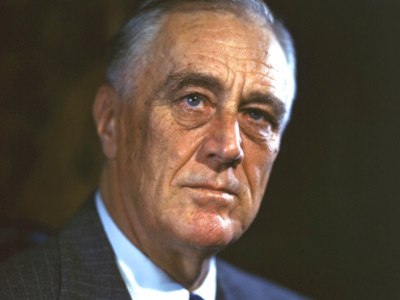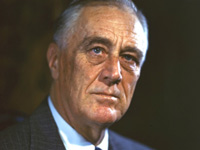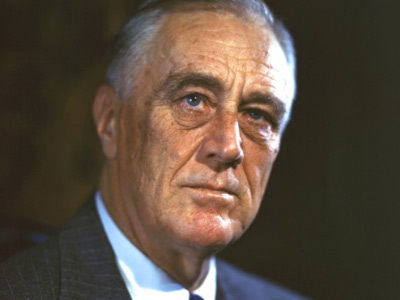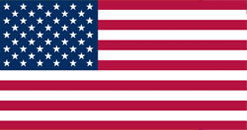Franklin Delano Roosevelt (1882-1945)

1932 Presidential Election
As the 1932 presidential election approached, Roosevelt increasingly turned his attention to national politics. He established a campaign team led by Howe and Farley and a "brain trust" of policy advisers. With the economy ailing, many Democrats hoped that the 1932 elections would see the election of the first Democratic president since Woodrow Wilson. Roosevelt's re-election had established him as the front-runner for the 1932 Democratic presidential nomination. Roosevelt rallied the progressive supporters of the Wilson while also appealing to many conservatives, establishing himself as the leading candidate in the South and West. The chief opposition to Roosevelt's candidacy came from Northeastern conservatives such as Al Smith, the 1928 Democratic presidential nominee. Smith hoped to deny Roosevelt the two-thirds support necessary to win the party's presidential nomination 1932 Democratic National Convention, and then emerge as the nominee after multiple rounds of balloting. Roosevelt entered the convention with a delegate lead due to his success in the 1932 Democratic primaries, but most delegates entered the convention unbound to any particular candidate. On the first presidential ballot of the convention, Roosevelt received the votes of more than half but less than two-thirds of the delegates, with Smith finishing in a distant second place. Speaker of the House John Nance Garner, who controlled the votes of Texas and California, threw his support behind Roosevelt after the third ballot, and Roosevelt clinched the nomination on the fourth ballot. With little input from Roosevelt, Garner won the vice presidential nomination. Roosevelt flew in from New York after learning that he had won the nomination, becoming the first major party presidential nominee to accept the nomination in person.
In his acceptance speech, Roosevelt declared, "I pledge you, I pledge myself to a new deal for the American people... This is more than a political campaign. It is a call to arms." Roosevelt promised securities regulation, tariff reduction, farm relief, government-funded public works, and other government actions to address the Great Depression. Reflecting changing public opinion, the Democratic platform included a call for the repeal of Prohibition; Roosevelt himself had not taken a public stand on the issue prior to the convention but promised to uphold the party platform. After the convention, Roosevelt won endorsements from several progressive Republicans, including George W. Norris, Hiram Johnson, and Robert La Follette Jr. He also reconciled with the party's conservative wing, and even Al Smith was persuaded to support the Democratic ticket. Hoover's handling of the Bonus Army further damaged the incumbent's popularity, as newspapers across the country criticized the use of force to disperse assembled veterans.
Roosevelt won 57% of the popular vote and carried all but six states. Historians and political scientists consider the 1932–36 elections to be realigning elections. Roosevelt's victory was enabled by the creation of the New Deal coalition, small farmers, the Southern whites, Catholics, big city political machines, labor unions, northern African Americans (southern ones were still disfranchised), Jews, intellectuals, and political liberals. The creation of the New Deal coalition transformed American politics and started what is called the "New Deal Party System" or (by political scientists) the Fifth Party System. Between the Civil War and 1929, Democrats had rarely controlled both houses of Congress and had won just four of seventeen presidential elections; from 1932 to 1979, Democrats won eight of twelve presidential elections and generally controlled both houses of Congress.
Roosevelt was elected in November 1932 but, like his predecessors, would not take office until the following March. After the election, Hoover sought to convince Roosevelt to renounce much of his campaign platform and to endorse the Hoover administration's policies. Roosevelt refused Hoover's request to develop a joint program to stop the downward economic spiral, claiming that it would tie his hands, and that Hoover had all the power to act if necessary. The economy spiraled downward until the banking system began a complete nationwide shutdown as Hoover's term ended. Roosevelt used the transition period to select the personnel for his incoming administration, and he chose Howe as his chief of staff, Farley as Postmaster General, and Frances Perkins as Secretary of Labor. William H. Woodin, a Republican industrialist close to Roosevelt, was the choice for Secretary of the Treasury, while Roosevelt chose Senator Cordell Hull of Tennessee as Secretary of State. Harold L. Ickes and Henry A. Wallace, two progressive Republicans, were selected for the roles of Secretary of the Interior and Secretary of Agriculture, respectively. In February 1933, Roosevelt escaped an assassination attempt by Giuseppe Zangara, who expressed a "hate for all rulers." Attempting to shoot Roosevelt, Zangara instead mortally wounded Chicago Mayor Anton Cermak, who was sitting alongside Roosevelt.
HISTORY

RESOURCES
This article uses material from the Wikipedia article "Franklin Delano Roosevelt (1882-1945)", which is released under the Creative Commons Attribution-Share-Alike License 3.0.
© Stories Preschool. All Rights Reserved.










